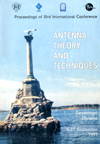Excitation problem solution for the dielectric cylinder with thin cover
DOI:
https://doi.org/10.1109/ICATT.1999.1236117Abstract
At present various electromagnetic radiation sources are widely used (for example, the cellular communication system operating at 450, 900 and 1800 MHz). Accordingly the interest to the problem of electro-magnetic fields interaction with biological tissues has been increased. The inhomogeneous cylinder may be one of the possible biological structure models [1]. Such model investigation allows to take advantage of a strict solution of an electromagnetic problem. In resonance range (the specified frequency range) a method of eigenfunctions is usually used. In accordance with it fields are decomposed into infinite series of eigefunctions. The unknown expansion factors are determined from boundary conditions. However, for biological media (with large values of dielectric constants) expansion series converge extremely slowly. With a multiple eigenfunctions evaluation using appropriate direct or inverse recurrence formulas a significant error may occur. Diffraction problems in this case involve special combinations of cylindrical functions [2, 3]. In practice often it is important to know the electromagnetic field distribution inside a dielectric structure. The homogeneous dielectric cylinder with a thin cover may serve as a model of such structure. In this case it is possible to build equivalent homogeneous model utilizing two-sided second-order boundary conditions [4, 5].References
Rudakov, M.L. Models of biological objects at investigations of interactions with electromagnetic fields in a radio wave range. Zarubejnaja Radioelectronika, 1998, No. 2, p. 68-75.
Chechetka, V.V.; Fedorenko, A.I. Excitation of multilayer cylindrical structure. Rassejanije Elektromagnitnych Voln, Taganrog, 1978, No. 2.
Vorontsov, A.A.; Mirovitskaya, S.D. Specific Functions of the Scattering Theory Problems. Handbook. Moscow: Radio i Sviaz, 1991 [in Russian].
Volakis, D.L.; Senior, T.B.A. Application of a class of generalized boundary conditions to scattering on a dielectric half-plane with metal substrate. TIIER, May 1989, Vol. 77, No. 5, p. 176-186.
Rojas, R.G.; Al-Hekail, Z. Generalized impedance/resistive boundary conditions for electromagnetic scattering problems. Radio Science, 1989, Vol. 24, No. 1, p. 1-12.
Markov, G.T.; Chaplin, A.F. Electromagnetic Waves Excitation. Moscow-Leningrad: Energija, 1967, 365 p.

